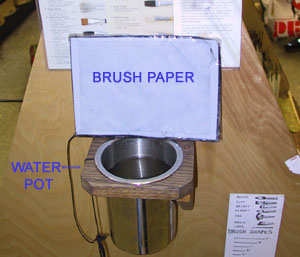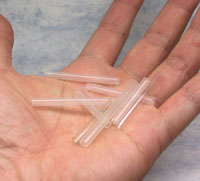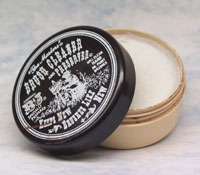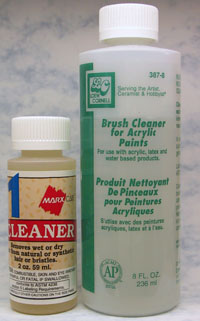Introduction
A paintbrush is probably the most important tool that you will purchase in helping you bring a miniature to life. With proper selection and care, a good quality paintbrush is an investment in the miniature-painting hobby, and can make the experience all the more enjoyable. With a fine tip, you, the painter will have more control in the application of paint, exactly where you want it to be. So take extra time in choosing and caring of your brushes, as they will result in your best possible work.
Anatomy of a paintbrush
In general most paintbrushes are still assembled by hand with brush tips made from either natural or synthetic hairs. These hairs are bound together with cord or nylon rope and then set into the metal ferrule with a wax based adhesive. The wooden or plastic handle is then pushed into the back of the ferrule and held in place with a crimp. Knowledge of how a paintbrush created is important, because it allows you to properly care for your brush. Because the adhesive that holds the brush hairs is wax based, you should never rinse your brushes in hot water. This can melt the adhesive, causing the hairs to unseat themselves, losing the valuable pointed shape necessary for fine control. Also, the contact point between the handle and ferrule is not waterproof. Any moisture that collects within this area from indiscriminate washing will cause a wooden handle to swell and then contract, resulting in loose paintbrush handles.
 Brush hair types
Traditionally paintbrushes were made with natural hairs. Today we have synthetic nylon bristle brushes specifically designed for use with acrylic paints. Sable brushes are generally regarded as the best material for natural hairs. Red sable is considered a good grade of material obtained from weasels, and the type of hair most novice painters are familiar with. Kolinsky Sable is the most expensive and highly regarded natural hair from tails of weasels found in Northeast Asia. It has an almost unnatural ability to hold a pointed shape due to the natural taper of the hair fibers. Paintbrushes made from ox, badger, goat, horse, or mongooses are not suitable for use in miniature painting, mainly due to their inability to hold a fine point.
Synthetic hair paintbrushes are a more recent innovation, made primarily from nylon or polyester fibers. They can also be manufactured with a tapered shape, and can have a stiffer feel compared to natural hairs. They are also more resistant to solvent damage, and do not wear out as easily as natural brushes. Low grade synthetic brushes will eventually curl at the tip, forming an annoying hooked shape.
Regardless of what kind of brush hair you choose, make sure it is the best quality you can afford, and be prepared to spend some time picking and choosing the best brushes available to you.
Where to purchase brushes
One of the best places to purchase paintbrushes is your local art supply store. Invariably they will have a larger selection of brushes, allowing you to choose from handle length, hair type, hair style, etc. I'm not trying to put your favorite hobby shop out of business, but if you are serious about painting to the best of your abilities, you owe it to yourself to broaden your horizons. One benefit of an art store is that you can actually "try out" the brushes. Better grades of brushes will come unpackaged, point up. A good art supply store will have a pot of water, and special brush paper for you to test the point of the brush. By dipping a brush in the water and painting several lines onto the paper provided, you can accurately judge if the brush has characteristics you desire. Dont worry, the water evaporates off the brush paper, and can be reused. In addition most art supply stores offer frequent sales and discounts if you have a student ID.

 Brush selection
When purchasing a paintbrush, you have to keep in mind what you are really paying for is the brush tip. This is really important because you are looking for a brush that comes to a fine taper, with no frayed hairs, and a sharp firm point that doesn't waver when you apply a brush stroke. When you find a brush without any visible damage, (such as bent hairs, etc.), dip it all the way to the ferrule into the water, flick off the excess, and form it to a sharp point with your fingers.
(Left to Right) pointed, "fishtail", stray hairs, hooked tip
Now test the point:
1) "Paint" several straight lines on the paper provided. Does the tip fishtail or break up?
2) Now paint little swirls on the brush paper. Any problems yet? If not you probably have a good brush.
3) Finally lightly "stab" the tip onto the paper, as if you were painting many tiny dots.

Does the brush still have a good point? If so, perfect! You now have a brush that exhibits good snap(ability to retain a pointed shape), a quality much desired by artists in their brushes. Now make sure you find another paintbrush with similar properties and purchase the best one. Dont forget to pick up a few caps to protect the brush hairs.
Care of your brushes during use
There are a few rules that I follow when using my paintbrushes. I never use the brush tips to mix paints. I never dip the tip of the brush into paint so deep that it gets into the ferrule. Any buildup of paint in the ferrule can cause the brush hairs to splay out, ruining a fine tip.
If I notice paint collecting near the ferrule, I stop painting immediately, and rinse the brush in warm water and soap. This is inevitable, because capillary action will draw paint up into the ferrule no matter how careful you are. The key is to stop and clean it out before paint has a chance to dry inside the ferrule. You can use this time as a break to change your water pot, and stretch out you back. In addition, wash your hands frequently when the brush feels slick after hours of painting.

Brush cleaning
After each painting session, take the time to carefully inspect your brush. Look for frayed hairs, and carefully tease them out if necessary. Purchase specially prepared "brush soaps". Various manufacturers sell these, and they safely remove the rings of paint under the ferrules easily. In addition they replace natural oils removed in most cleaning processes. Use brush soap to remove any paint you find between fibers and under the ferrule according to the instructions. If you paint frequently, condition your brush one a month or so. I use shampoo with conditioner on them. Swish your brush in some hair conditioner, wipe off the excess, shape to a point then leave it upright for an hour or so. Rinse off well with lukewarm water, then with a little brush soap, shape to a perfect point. Let it stand upright with a cap on them. I actually put my brushes in the same cabinet as my miniatures, so they will remain dust free!!!!!

A newer product you should try is liquid brush cleaner. Liquid brush cleaners do an even better job than most bar or tub style brush soaps. Being quite viscous, liquid brush clean actually works its way up the bristles into the ferrules, dissolving trapped paint. Even previously cleaned brushes (using brush soap) will rinse out with dirty paint flecks.
These days, I clean my brushes with liquid brush soap, and condition and shape the tip with bar style brush soap to get the best of both worlds.
My Favorite brushes
My preferred brushes are the vaunted Winsor and Newton Series 7. The are alleged to have been commissioned by the queen of England herself back in the late 1800s. I've been using these brushes for 3 years now, and haven't found any better for my painting style. Be warned, they are extremely expensive. A 3/0 can run $14USD or more. But are certainly worth their price. They hold a fine point, have the desired "spring" when laying on paint, and are very resilient to wear. They have the right balance between a fiber that is too limp (cheap nylon) and too stiff (hog hair bristle). I heartily recommend them if you are willing spend the money. I have also tried various brands of fine sables with success from Raphael and Isbly.
Regardless of the of the brushes I prefer, every miniature painter should find a brand of brush that suites their particular style of painting and requirements. If possible, experiment with different manufacturers and hair types; I'm currently trying out various synthetic/natural blends to test their suitibility for my purposes.

I hope this article has been of interest to you. There are many more articles on the Internet that deal with brush selection and care; I hope I have succinctly provided all the necessary information to help you choose and protect your investment. Proper care of your finest tools is not a guarantee for painting excellence! It can certainly make things easier while painting; for you can now concentrate on technique, rather than make due with a poorly maintained brush.
|



